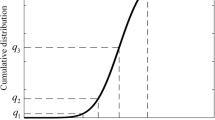Abstract
The computation of the sensitivity of a Madaline’s output to its parameter perturbation is systematically discussed. Firstly, according to the discrete feature of Adalines, a method based on discrete stochastic technique is proposed, which derives some analytical formulas for the computation of Adalines’ sensitivity. The method can theoretically solve some problems that are unsolvable by the existing methods based on continuous stochastic techniques, release some unpractical constraints, and make it available to theoretically analyze the approximation error of Adalines’ sensitivity. Secondly, on the basis of the sensitivity of Adalines and the structural characteristics of Madalines, a new selection strategy depending on a type of dedication degree for computing Madalines’ sensitivity is proposed, which is superior to current popular way of simply averaging in both precision and complexity. The proposed formulas and algorithm have the advantages of simplicity, low computational complexity, small approximation error, and high generality, as have been verified by a great amount of experimental simulations.
Similar content being viewed by others
References
Hoff M E, Jr. Leaning phenomena in networks of adaptive switching circuits. PhD dissertation. Stanford: Dept. Electrical Eng., Stanford Univ., 1962. 1–91
Glanz F H. Statistical extrapolation in certain adaptive pattern recognition systems. PhD dissertation. Stanford: Dept. Electrical Eng., Stanford Univ., 1965. 1–142
Winter R G. Madaline rule II: a new method for training networks of Adalines. PhD dissertation. Stanford: Dept. Electrical Eng., Stanford Univ., 1989. 1–91
Stevenson M, Winter R, Widrow B. Sensitivity of feedforward neural networks to weight errors. IEEE Trans Neural Netw, 1990, 1: 71–80
Choi J Y, Choi C H. Sensitivity analysis of multilayer perceptron with differentiable activation functions. IEEE Trans Neural Netw, 1992, 3: 101–107
Piché S W. The selection of weight accuracies for Madalines. IEEE Trans Neural Netw, 1995, 6: 432–445
Alippi C, Piuri V, Sami M G. Sensitivity to errors in artificial neural networks: a behavioral approach. IEEE Trans Circuits Syst I-Regul Pap, 1995, 42: 358–361
Oh S H, Lee Y. Sensitivity analysis of a single hidden-layer neural networks with threshold function. IEEE Trans Neural Netw, 1995, 6: 1005–1007
Cheng A Y, Yeung D S. Sensitivity analysis of neocognitron. IEEE Trans Syst Man Cybern C, 1999, 29: 238–249
Zeng X, Yeung D S. Sensitivity analysis of multilayer Perceptron to input and weight perturbations. IEEE Trans Neural Netw, 2001,12: 1358–1366
Yeung D S, Sun X. Using function approximation to analyze the sensitivity of the MLP with antisymmetric squashing activation function. IEEE Trans Neural Netw, 2002, 13: 34–44
Zeng X, Yeung D S. A quantified sensitivity measure for multilayer perceptron to input perturbation. Neural Comput, 2003, 15: 183–212
Zeng X, Wang Y, Zhang K. Computation of Adalines’ sensitivity to weight perturbation. IEEE Trans Neural Netw, 2006, 17: 515–519
Wang Y, Zeng X, Yeung D S, et al. Computation of Madalines’ sensitivity to input and weight perturbations. Neural Comput, 2006, 18: 2854–2877
Zurada J M, Malinowski A, Usui S. Perturbation method for deleting redundant inputs of perceptron networks. Neurocomput, 1997, 14: 177–193
Bernier J L, Ortega J, Rojas I, et al. Improving the tolerance of multilayer perceptrons by minimizing the statistical sensitivity to weight deviations. Neurocomput, 2000, 31: 87–103
Bernier J L, Ortega J, ROS E, et al. A quantitive study of fault tolerance, noise immunity and generalization ability of MLPs. Neural Comput, 2000, 12: 2941–2964
Engelbrecht A P. A new pruning heuristic based on variance analysis of sensitivity information. IEEE Trans Neural Netw, 2001, 12: 1386–1399
Zeng X, Yeung D S. Hidden neuron pruning of multilayer Perceptrons using a quantified sensitivity measure. Neurocomput, 2006, 69: 825–837
Yeung D, Ng W, Wang D, et al. Localized generalization error model and its application to architecture selection for radial basis function neural network. IEEE Trans Neural Netw, 2007, 18: 1294–1305
Zeng X, Shao J, Wang Y, et al. A sensitivity-based approach for pruning architecture of Madalines. Neural Comput Appl, 2009, 18: 957–965
Author information
Authors and Affiliations
Corresponding author
Rights and permissions
About this article
Cite this article
Zhong, S., Zeng, X., Liu, H. et al. Approximate computation of Madaline sensitivity based on discrete stochastic technique. Sci. China Inf. Sci. 53, 2399–2414 (2010). https://doi.org/10.1007/s11432-010-4122-6
Received:
Accepted:
Published:
Issue Date:
DOI: https://doi.org/10.1007/s11432-010-4122-6




